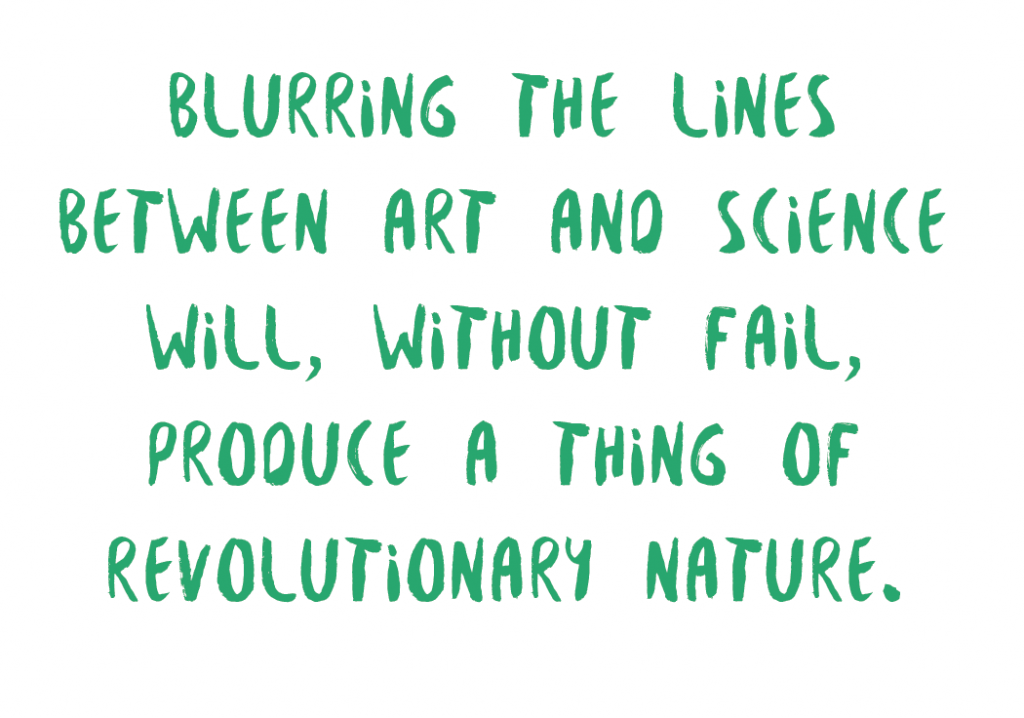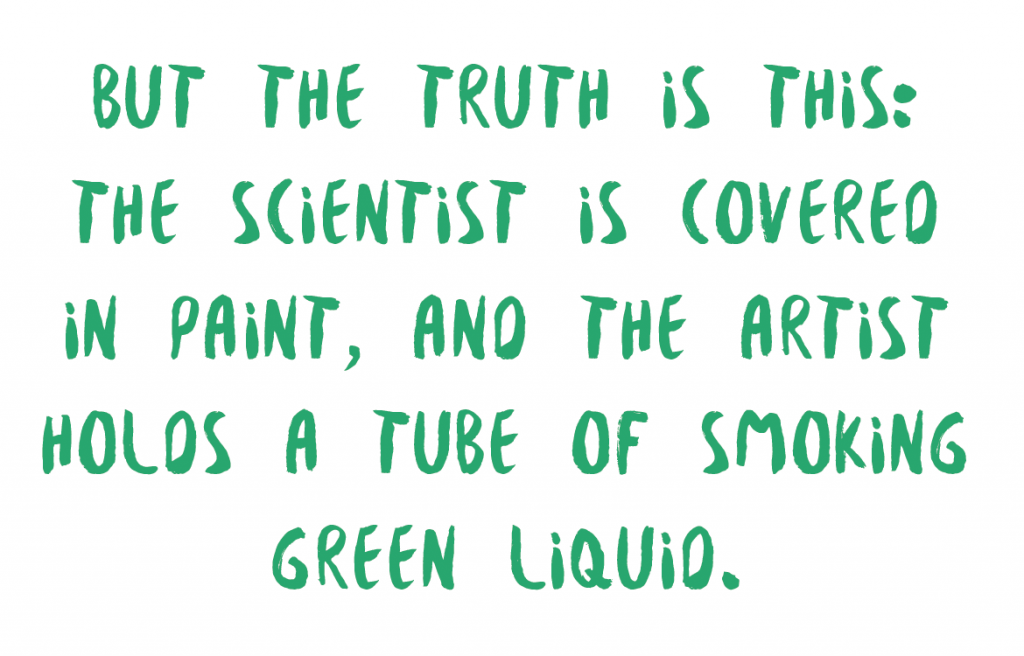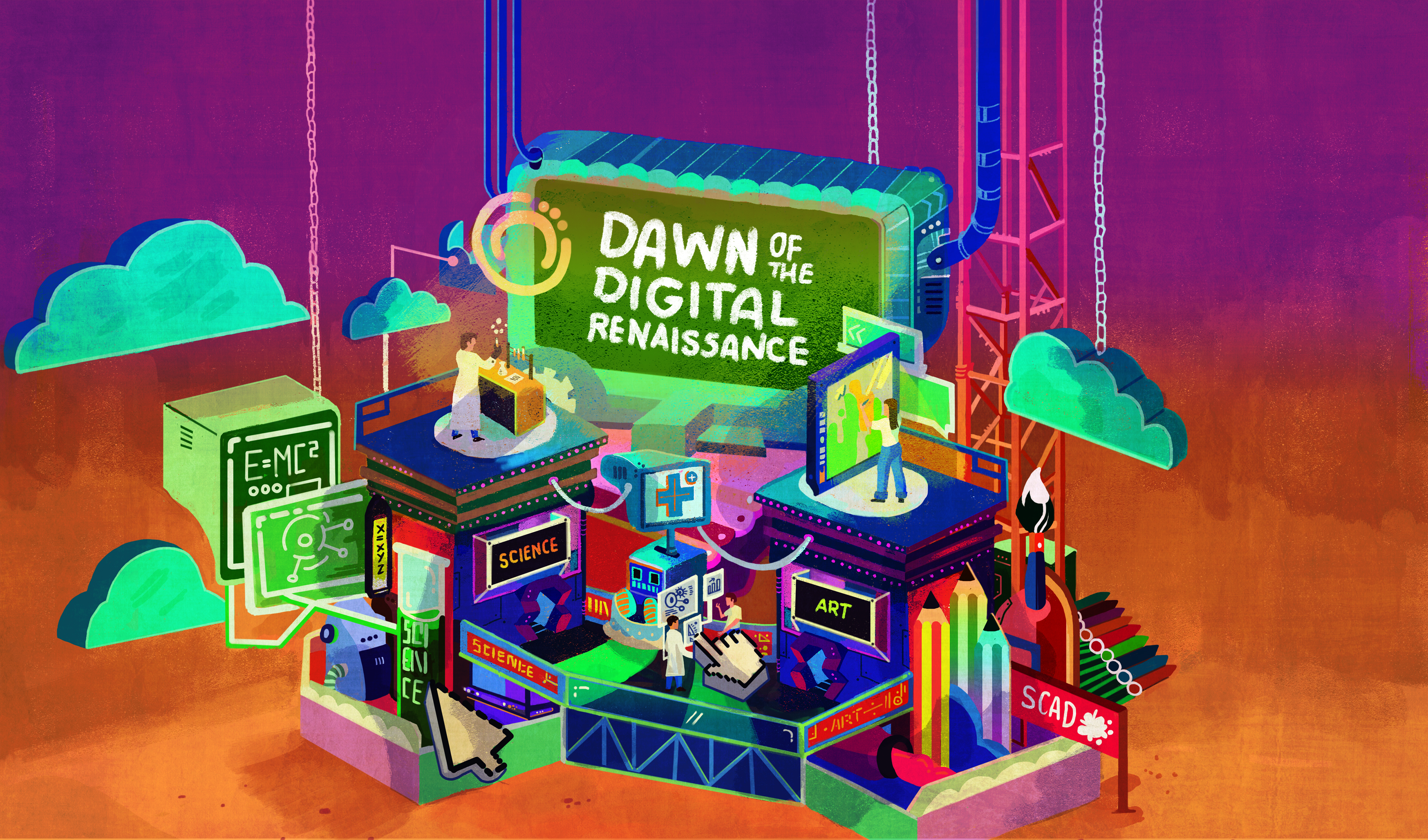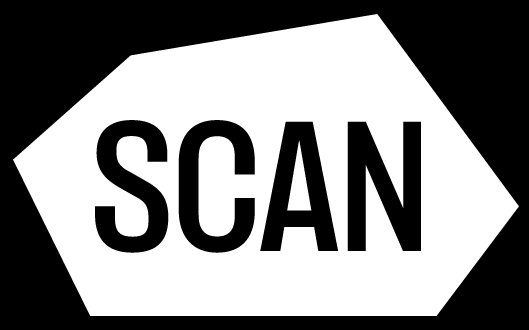WRITTEN BY MARIAN HILL
ILLUSTRATED BY KIRE TORRES
During the course of human history lurching forward to the present, there was a separation of the artist and the scientist. They were placed at opposite ends of a spectrum. At one end stands the scientist, a figure in a white lab coat, rounded glasses and a tube of smoking green liquid. At the other end stands the artist, a figure in a paint-stained smock, tangled hair and charcoal-covered fingertips. We imagine them as total opposites, and somewhere along the lines of time, these two were put in different boxes. This departure from each other can be seen as one of the major setbacks in humankind’s progress.
The initial separation of art from science made the subjects, and those who work in each, bitter rivals. However, there is a point in the life of an artist and of a scientist when each will realize how incredibly homogenous their lines of work are. Strip away all the titles and technicalities of both, the only differentiating quality is this: an artist creates and a scientist discovers.
At the very core of science, discovery is based on action and reaction. The discovery of fire, marking the beginning of humanity’s scientific journey, was founded in lightning striking a tree, then rubbing sticks to make friction and then burning coal into heat. The first moment a human created a fire was the first instance of a scientist using their own discovery for their benefit. Their observations of interactions within natural worlds became a means of survival and later, of expression and representation. The very first art was, in fact, a recollection of observation. What those older than ancient people saw day-by-day was captured on rocky interiors. Their lives were observed by each other and used to decorate their homes. It was observation that inspired humanity’s first calendar made by the Mesolithic people, it was observation that inspired the paintings of cavemen and it was observation that inspired the first man-made fire. That element of seeing, noticing and acknowledging the importance of the world brought to life the two major ways to interpret existence: art and science.
From the beginning, art and science were barreling towards each other at high speed, preparing for a head-on collision. An early clue of this was Arab mathematician Ibn al-Haytham of the Islamic Golden Age. He is credited with the first properly built camera obscura (English translation “obscured space” or “dark room”). This invention, found in Ibn al-Haytham’s “Book of Optics,” is the basic theory of photography and the science behind any working camera. See how easily we started down the trail of science and found ourselves in art? Both are too deeply interwoven in concept. A quick search online reveals that even in their own definitions they do not stray far from each other, for the word “art” is a synonym of “science.” Finding one in the other becomes unavoidable.
Every prominent mind of the Renaissance embraced the wonderful notion that the power of both art and science would propel human ingenuity forward. Take Leonardo da Vinci; his name rings respect in every textbook known to mankind on a vast number of subjects. “The Vitruvian Man” contributes to both worlds of art and science by showing how the human body can fit proportionally into a square and a circle based on the studies of ancient architecture.
Another man of the Renaissance who studied structures like Leonardo, Filippo Brunelleschi, left Rome and returned to Florence after his loss in the competition to design the Paradise Gates with a mind full of engineering. According to the Public Broadcasting Service, he was “especially interested in Roman engineering and the use of fixed proportion and Roman vaults.” He was one of the first to apply safety regulations when building the dome in the Piazza del Duomo. Brunelleschi, who started off as a goldsmith, built the “greatest architectural feat in the Western world,” according to PBS, with no professional training in architecture.
Chemistry and art changed the face of painting forever during the Renaissance. In Giorgio Vasari’s “Lives of the Artists,” Giovanni da Bruggia experimented with modifying oil paint to make a varnish that could “dry in the shade without putting [the] paintings in the sun.” A simple chemical revision of the most popular medium of art at the time impacted not only the colors artists could use, but also allowed the colors and shadows to be even more so diuturnal.
 Blurring the lines between art and science will, without fail, produce a thing of revolutionary nature. It is more apparent now in the modern age — art and science are coalescing once again. Scientists and artists alike are realizing how compatible their passions and ways of thinking are and how to use this new found relationship as a way to elevate their work. Dancing upon the line between art and science, they intend to wash away the stereotypes. While the inspiration of using art and science in innovative processes comes from the works of Renaissance men, the future of the two subjects in the modern world holds a respectable spot for female polymaths.
Blurring the lines between art and science will, without fail, produce a thing of revolutionary nature. It is more apparent now in the modern age — art and science are coalescing once again. Scientists and artists alike are realizing how compatible their passions and ways of thinking are and how to use this new found relationship as a way to elevate their work. Dancing upon the line between art and science, they intend to wash away the stereotypes. While the inspiration of using art and science in innovative processes comes from the works of Renaissance men, the future of the two subjects in the modern world holds a respectable spot for female polymaths.
 American-Israeli Massachusetts Institute of Technology Professor Neri Oxman produces works that many consider both incredible art and ground-breaking science. Oxman invented the study of material ecology — a field of biologically and digitally engineering designs through the study of material types. Her model of a breathable skin known as “Cartesian Wax,” once on display in the Museum of Modern Art, is “inspired by the Cartesian Wax thesis as elucidated by Descartes in the 1640s” and also relative to “the construction of material perception and effect in our experience of the physical world,” according to Oxman’s official webpage. This breathable skin’s main purpose is to be used in architecture as a way to produce “dynamic buildings that adapt to changing environmental conditions and levels of occupancy,” according to MoMA.
American-Israeli Massachusetts Institute of Technology Professor Neri Oxman produces works that many consider both incredible art and ground-breaking science. Oxman invented the study of material ecology — a field of biologically and digitally engineering designs through the study of material types. Her model of a breathable skin known as “Cartesian Wax,” once on display in the Museum of Modern Art, is “inspired by the Cartesian Wax thesis as elucidated by Descartes in the 1640s” and also relative to “the construction of material perception and effect in our experience of the physical world,” according to Oxman’s official webpage. This breathable skin’s main purpose is to be used in architecture as a way to produce “dynamic buildings that adapt to changing environmental conditions and levels of occupancy,” according to MoMA.
Zaha Hadid claims one of the top spots in revolutionary contemporary architecture as the first woman to ever win the Pritzker Architecture Prize, according to Michael Kimmelman of The New York Times. One of her most immaculate designs is known as the “Zaha Hadid Chandelier,” which she and Swarovski Crystal Palace worked on together. This grand lighting fixture was constructed with micro-printed LED lights that illuminate 2,700 crystals. The visual motion of the design finds its inspiration in “self-organizing systems and nanotechnology,” according to Hadid’s official webpage. Micro-printing is most commonly used for currency and, according to a guide on currency provided by the U.S. Currency Education Program, “microprinting is featured in several locations on denominations $5 and higher.” By taking advantage of technology primarily used on currency and checks, an artist was able to bring in refinement and shape control to her work to elevate the sensation of viewing her piece.
The bettering of an experience drives art and science to satisfy the senses. Much like how da Bruggia experimented with oil paintings to enhance the visual beauty of paintings, the modern world has continuously advanced technologies that lend aid to the world of entertainment. In 2015, Europe established its first IMAX theater that incorporated a laser digital projection system, according to Sebastian Anthony of Arstechnica. Laser technology improved the movie viewing experience with the enhancement of “brightness, contrast or color space” in projectors. The technology in these projectors is a modified version of Texas Instruments DLP chip that is typically used for display devices. Anthony explained that “thermal stability of invar (a nickel-iron alloy)” replaces the standard prism inside the device and “increases image sharpness and provides blacker blacks.”
 The use of virtual reality headsets in galleries has radically changed the traditional method and experience of viewing art. According to Robert Elder and Kevin Gallagher of Business Insider, “Google-owned Tilt Brush [is] a platform for artists to digitally sketch and create 3D content in a virtual reality environment.” In 2017, Tilt Brush launched a virtual gallery featuring 3D art content and has been placed in physical gallery settings. Embracing VR headsets in the gallery experience embraces the future of art and technology without forgetting the past of traditional artistry.
The use of virtual reality headsets in galleries has radically changed the traditional method and experience of viewing art. According to Robert Elder and Kevin Gallagher of Business Insider, “Google-owned Tilt Brush [is] a platform for artists to digitally sketch and create 3D content in a virtual reality environment.” In 2017, Tilt Brush launched a virtual gallery featuring 3D art content and has been placed in physical gallery settings. Embracing VR headsets in the gallery experience embraces the future of art and technology without forgetting the past of traditional artistry.
Artists have shown a definite fear of the tech world invading the art world. The Pew Research Center conducted a large survey in an attempt to see how those in the art organization and presentation circles view the impact of technology on art and experiences. One quote from the study reads as follows: “Some ideas cannot be condensed into 140 characters or less. I hope technologies do not negatively affect the playwright. I hope the playwright does not write solely for a Twitter generation.”
Forever it has been necessary for art and science to connect, but the fear of them doing so has grown immense. It is that fear that humanity holds fast to. It speaks to the notion that art and science should be kept far apart. But the truth is this: the scientist is covered in paint, and the artist holds a tube of smoking green liquid. The two minds realize, as they look at one another, that nothing is different, nothing is separate. No matter how hard people try to drive a wedge between these two things, the gap closes up again with the actions, words and thoughts of those who need to create and discover. Finding out more about ourselves as human beings, as things that live and breathe by way of art and science, is not an option. It is the road we are heading down regardless. For art is creation and science is discovery, but in the end, everything else is simply life.

